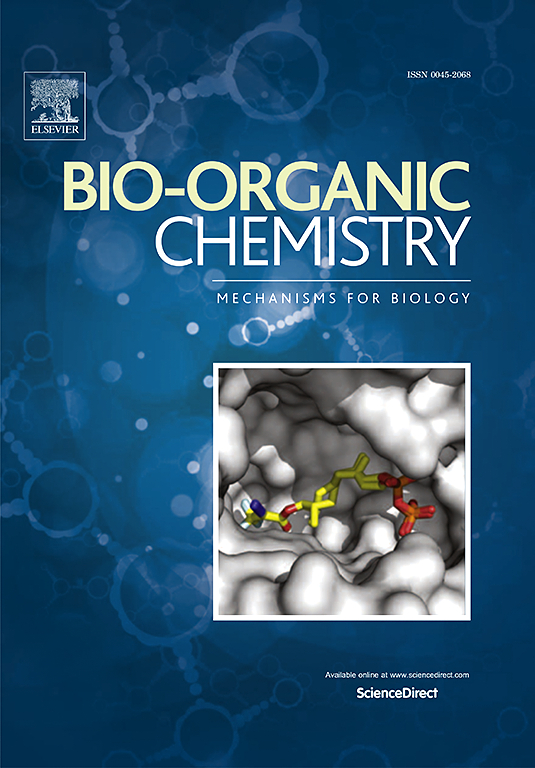新型烷磺酸基喹唑啉酮-乙酰肼支架:合理设计、合成、分子对接、抗癌性能及潜在的EGFR及其T790M/L858R突变抑制剂
IF 4.5
2区 医学
Q1 BIOCHEMISTRY & MOLECULAR BIOLOGY
引用次数: 0
摘要
利用喹唑啉酮的潜在抗癌特性,我们设计、合成了两个新系列的喹唑啉酮基支架 3a-i 和 7a-i,并在三种不同的人类癌症细胞系(HepG-2、MCF-7 和 HCT-116)和一种正常细胞系(BJ-1)中扫描了它们的抗癌功效。参考药物为厄洛替尼和多柔比星。值得注意的是,衍生物 3i 和 7f 对 HepG-2 的活性最强,IC50 值分别为 1.66 μM 和 1.67 μM,比厄洛替尼和多柔比星(IC50 分别为 2.85 μM 和 4.25 μM)高出约两倍。此外,化合物 7i 对 MCF-7 显示出更优越的疗效,IC50 为 3.25 μM,优于厄洛替尼和多柔比星(IC50 分别为 3.56 μM 和 5.38 μM)。就结肠癌(HCT-116)而言,与厄洛替尼和多柔比星相比,化合物 7i 也显示出最高的细胞毒性活性(IC50 = 1.20 μM,而厄洛替尼和多柔比星分别为 3.05 μM 和 5.70 μM)。值得注意的是,大多数测试化合物对正常人细胞系(BJ-1)具有良好的安全性。此外,与参考药物厄洛替尼相比,这些衍生物除了对表皮生长因子受体(EGFR)的突变(EGFRL858R 和 EGFRT790M)有明显的抑制作用外,还对表皮生长因子受体(EGFR)有明显的抑制作用。与厄洛替尼相比,化合物 7f 显著增加了 Bax 和 Bcl-2 的水平,分别增加了 1.9 倍和 1.3 倍。此外,7f还能诱导凋亡效应,使细胞周期停滞在G0/G1期,并停止HepG-2细胞的有丝分裂周期。为了进一步验证这些发现,我们对前景看好的衍生物 7i 和 7f 进行了对接模拟,以评估它们与表皮生长因子受体及其 T790M/L858R 突变体的预期结合亲和力。因此,化合物 7f 有潜力开发成一种强效抗癌剂。本文章由计算机程序翻译,如有差异,请以英文原文为准。

New alkanesulfonate-based quinazolinone-acetohydrazide scaffolds: Rational design, synthesis, molecular docking, anticancer properties and potential EGFR and its T790M/L858R mutants inhibitors
Leveraging their potential anticancer properties, two novel series of quinazolinone-based scaffolds, 3a-i and 7a-i, have been designed, synthesized, and scanned for their anticancer efficacy across three diverse human cancer cell lines, HepG-2, MCF-7, and HCT-116, alongside a normal cell line (BJ-1). Erlotinib and Doxorubicin served as the reference drugs. Notably, derivatives 3i and 7f exhibited the most potent activity against HepG-2, with IC50 values of 1.66 μM and 1.67 μM, respectively, demonstrating about two-fold greater potency than erlotinib and doxorubicin (IC50 = 2.85 μM and 4.25 μM, respectively). Additionally, compound 7i showed superior efficacy against MCF-7 with an IC50 of 3.25 μM, outperforming erlotinib and doxorubicin (IC50 = 3.56 μM and 5.38 μM, respectively). In the case of colon cancer (HCT-116), compound 7i also displayed the highest cytotoxic activity compared to erlotinib and doxorubicin (IC50 = 1.20 μM versus 3.05 and 5.70 μM, respectively). Notably, most tested compounds exhibited a favorable safety profile against the normal human cell line (BJ-1). Furthermore, the derivatives demonstrated significant inhibitory properties on the Epidermal Growth Factor Receptor (EGFR) besides its mutations, EGFRL858R and EGFRT790M, compared with Erlotinib, the reference drug. Compound 7f notably increased Bax and Bcl-2 levels by 1.9 and 1.3 folds, respectively, relative to Erlotinib. Moreover, 7f induced the apoptotic effect, arrested the cell cycle at the G0/G1 phase, and halted the mitotic cycle in HepG-2 cells. To further validate these findings, docking simulations of the promising derivatives 7i and 7f were conducted to assess their anticipated binding affinities with EGFR and its T790M/L858R mutants. Thus, compound 7f has the potential to be developed into a potent anticancer agent.
求助全文
通过发布文献求助,成功后即可免费获取论文全文。
去求助
来源期刊

Bioorganic Chemistry
生物-生化与分子生物学
CiteScore
9.70
自引率
3.90%
发文量
679
审稿时长
31 days
期刊介绍:
Bioorganic Chemistry publishes research that addresses biological questions at the molecular level, using organic chemistry and principles of physical organic chemistry. The scope of the journal covers a range of topics at the organic chemistry-biology interface, including: enzyme catalysis, biotransformation and enzyme inhibition; nucleic acids chemistry; medicinal chemistry; natural product chemistry, natural product synthesis and natural product biosynthesis; antimicrobial agents; lipid and peptide chemistry; biophysical chemistry; biological probes; bio-orthogonal chemistry and biomimetic chemistry.
For manuscripts dealing with synthetic bioactive compounds, the Journal requires that the molecular target of the compounds described must be known, and must be demonstrated experimentally in the manuscript. For studies involving natural products, if the molecular target is unknown, some data beyond simple cell-based toxicity studies to provide insight into the mechanism of action is required. Studies supported by molecular docking are welcome, but must be supported by experimental data. The Journal does not consider manuscripts that are purely theoretical or computational in nature.
The Journal publishes regular articles, short communications and reviews. Reviews are normally invited by Editors or Editorial Board members. Authors of unsolicited reviews should first contact an Editor or Editorial Board member to determine whether the proposed article is within the scope of the Journal.
 求助内容:
求助内容: 应助结果提醒方式:
应助结果提醒方式:


